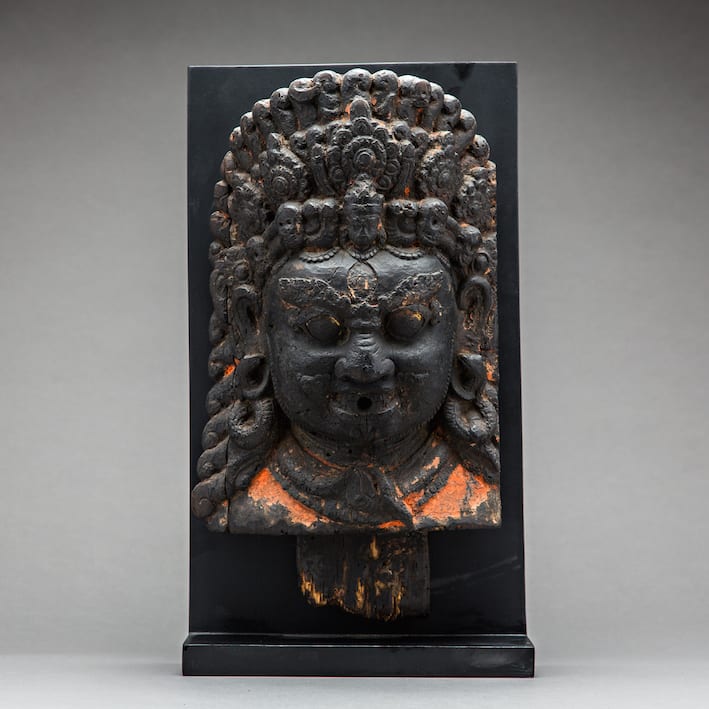Nepalese Wooden Mask of Bhairava, 1500 CE - 1700 CE
Wood
35.6 x 21 cm
14 x 8 1/4 in
14 x 8 1/4 in
LO.604
The representation of Shiva's head in the middle of this deity’s hair-dress, and his third eye (urna) in the middle of his forehead, confirm this image as that of Shiva...
The representation of Shiva's head in the middle of this deity’s hair-dress, and his third eye (urna) in the middle of his forehead, confirm this image as that of Shiva in one of his major wrathful avataras, Bhairava. Bhairava is an ancient Hindu god, possibly even predating his Shiva’s incarnation, a fearful destroyer who would take pleasure in the destruction of various demons and other evil beings. This spirit, whose name literally means 'terrible', emanates from Shiva's samhara-murti forms and both Hindus and Buddhists (conceived in the form of Mahakala), try to appease him. This large and impressive head of Bhairava probably originally adorned an entrance to a shrine, a familiar feature of Nepali religious architecture. Most probably this face was also designed to be used in processions.
His face is adorned with a crown with diadems, snakes, skulls, strings of pearls; the central diadem bearing an image (head) of Shiva. His two large circular earrings are both depicting snakes following the outline of the circle with their heads raised towards the god. He is depicted with flaming locks of hair, a large urna (sign of illumination), a curly beard, a moustache, large eyebrows, and a snake sliding around his neck on top of his elaborate necklace. The worship of serpents or snakes (nagas) has been prevalent in Nepal from a very early time. These benevolent deities are connected with Shiva, being part of his terrifying aspect and symbolize the cycles of time.
Bhairava also features a small circular opening in his full mouth, through which a pipe was probably inserted to serve consecrated beer to his devotees. Indeed, in the Newari culture of Nepal, on certain festival days a mask of Bhairava called hathwandya (“ beer-pour god”) is set up and beer or spirits are poured from a tube projecting from a hole in the mouth. Yet this Dionysian type of festival is unique to the Newari culture in Kathmandu.
The art of the Malla period reflects the stylistic characteristics and artistic taste of the monarchs, and can be considered a highlight in the art history of Nepal. The high quality of the carving and the lively imagination exemplify the skills of the Newari masters during that period. Typical elements are the pronounced and detailed structure of the head, the shape of the tiara with circular diadems decorated with lotus motifs and jewelry, the shape of the earrings and necklace, both decorated with the same motifs and pearls.
The importance of this impressive head is shown by the consistency of high quality pronounced carving. All details are captured within a strong and simple conceptualization with the flaming hair serving as a frame for the main shape. Bhairava is portrayed with a round and lively face, expressing an amazing power. His large circular open eyes and smiling mouth are part of his twofold manifestation; on one hand he is the great destroyer expressing his terrifying aspects needed in order to accomplish his task, on the other hand he reveals an open and friendly humanity as he feels compassion with his devotees. The superbly carved features and the directness of the expressive energies he radiates, make this head of Bhairava among the finest examples known.
His face is adorned with a crown with diadems, snakes, skulls, strings of pearls; the central diadem bearing an image (head) of Shiva. His two large circular earrings are both depicting snakes following the outline of the circle with their heads raised towards the god. He is depicted with flaming locks of hair, a large urna (sign of illumination), a curly beard, a moustache, large eyebrows, and a snake sliding around his neck on top of his elaborate necklace. The worship of serpents or snakes (nagas) has been prevalent in Nepal from a very early time. These benevolent deities are connected with Shiva, being part of his terrifying aspect and symbolize the cycles of time.
Bhairava also features a small circular opening in his full mouth, through which a pipe was probably inserted to serve consecrated beer to his devotees. Indeed, in the Newari culture of Nepal, on certain festival days a mask of Bhairava called hathwandya (“ beer-pour god”) is set up and beer or spirits are poured from a tube projecting from a hole in the mouth. Yet this Dionysian type of festival is unique to the Newari culture in Kathmandu.
The art of the Malla period reflects the stylistic characteristics and artistic taste of the monarchs, and can be considered a highlight in the art history of Nepal. The high quality of the carving and the lively imagination exemplify the skills of the Newari masters during that period. Typical elements are the pronounced and detailed structure of the head, the shape of the tiara with circular diadems decorated with lotus motifs and jewelry, the shape of the earrings and necklace, both decorated with the same motifs and pearls.
The importance of this impressive head is shown by the consistency of high quality pronounced carving. All details are captured within a strong and simple conceptualization with the flaming hair serving as a frame for the main shape. Bhairava is portrayed with a round and lively face, expressing an amazing power. His large circular open eyes and smiling mouth are part of his twofold manifestation; on one hand he is the great destroyer expressing his terrifying aspects needed in order to accomplish his task, on the other hand he reveals an open and friendly humanity as he feels compassion with his devotees. The superbly carved features and the directness of the expressive energies he radiates, make this head of Bhairava among the finest examples known.



